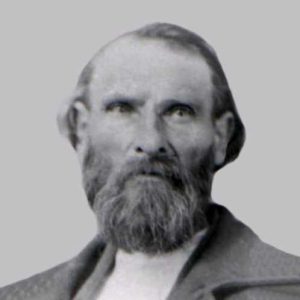George W. Johnson: A Life of Faith, Trials, and Devotion to the Latter-day Saint Movement

[tta_listen_btn]

On a winter day in 1823, in the town of Pomfret, Chautauqua Co., New York, George W. Johnson entered the world. The son of Ezekiel and Julia (Hills) Johnson, he was destined to become a pivotal figure in the early days of the Church of Jesus Christ of Latter-day Saints.
George’s early years were rooted in the spiritual teachings of his mother, a devout Presbyterian. Little did the family know that a visit from George’s brother Joel, carrying with him a Book of Mormon, would reshape their beliefs and destiny. It wasn’t long before more elders visited the Johnson household, leading to several family members, including George’s mother, embracing the teachings of Joseph Smith and getting baptized.
The Lord’s revelations were not just spiritual; they also required physical commitment. In 1833, the Johnson family heeded a divine call to contribute to the construction of the Kirtland Temple. George and his brothers worked diligently on the temple, witnessing miracles like the discovery of a ledge of building stone, which the Prophet had foreseen in a vision.
The following years were a whirlwind of spiritual highs and life-changing events. George relocated with his family to Ohio, where he became closely acquainted with the Prophet Joseph Smith and other church leaders. He attended a “Hebrew Bible School” and witnessed the celestial phenomenon of the “falling of the stars” in 1833. George also had the honor of being baptized in the Kirtland Temple and confirmed by the Prophet himself.
Life, however, wasn’t without its challenges. The move to Missouri in 1838 brought with it threats from hostile mobs. The Saints’ journey was fraught with hardships, from disease outbreaks to resource shortages. But George’s family, resilient and guided by their faith, persevered.
By 1844, George had settled in Nauvoo, Illinois, and had wedded his beloved, Maria Jane Johnston. This period of his life brought him even closer to the Prophet’s family. His brother Benjamin even became the Prophet’s Private Secretary. These were turbulent times, with the Saints facing persecution and the tragic martyrdom of the Prophet and his brother Hyrum.
The destruction didn’t end there. George bore witness to another heart-wrenching event – the burning of the Nauvoo Temple by an enraged mob in 1848. However, his spirit remained unbroken. In the spring of 1851, with his family by his side, George embarked on a journey to Salt Lake Valley. Despite the challenges they faced, from being surrounded by buffaloes to battling storms, the family’s faith carried them through.
George W. Johnson’s life is a testament to the indomitable spirit of the early Saints. Through trials, persecution, and personal loss, he remained steadfast in his faith and devotion to the gospel. He saw the Prophet Joseph Smith not just as a religious leader but as a beacon of integrity, loyalty, and kindness. Today, his legacy stands as a shining example of unwavering faith and resilience in the face of adversity.

